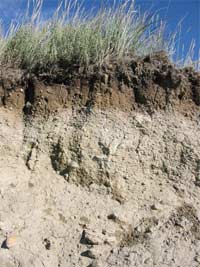A team from Newcastle University aims to design soils that can remove carbon from the atmosphere, permanently and cost-effectively. This has never previously been attempted anywhere in the world. The research is being funded by the Engineering and Physical Sciences Research Council.
The concept underlying the initiative exploits the fact that plants, crops and trees naturally absorb atmospheric carbon dioxide (CO2) during photosynthesis and then pump surplus carbon through their roots into the earth around them. In most soils, much of this carbon can escape back to the atmosphere or enters groundwater.
But in soils containing calcium-bearing silicates (natural or man-made), the team believe the carbon that oozes out of a plant's roots may react with the calcium to form the harmless mineral calcium carbonate. The carbon then stays securely locked in the calcium carbonate, which simply remains in the soil, close to the plant's roots, in the form of a coating on pebbles or as grains.
The scientists are investigating whether this process occurs as it may encourage the growing of more plants, crops etc in places where calcium-rich soils already exist. It would also open up the prospect that bespoke soils can be designed (i.e. with added calcium silicates, or specific plants) which optimise the carbon-capture process. Such soils could play a valuable role in carbon abatement all over the globe.
The team will first try to detect calcium carbonate in natural soils that have developed on top of calcium-rich rocks or been exposed to concrete dust (which contains man-made calcium silicates). They will then study artificial soils made at the University from a mixture of compost and calcium-rich rock. Finally, they will grow plants in purpose-made soils containing a high level of calcium silicates and monitor accumulation of calcium carbonate there.
The multi-disciplinary research team, including civil engineers, geologists, biologists and soil scientists, is led by David Manning, Professor of Soil Science at Newcastle University. "Scientists have known about the possibility of using soil as a carbon 'sink'* for some time," says Professor Manning. "But no-one else has tried to design soils expressly for the purpose of removing and permanently locking up carbon. Once we’ve confirmed the feasibility of this method of carbon sequestration, we can develop a computer model that predicts how much calcium carbonate will form in specific types of soil, and how quickly. That will help us engineer soils with optimum qualities from a carbon abatement perspective. A key benefit is that combating climate change in this way promises to be cheap compared with other processes."
Significant scope could exist to incorporate calcium-rich, carbon-locking soils in land restoration, land remediation and other development projects. Growing bioenergy crops on these soils could be one attractive option.
"The process we’re exploring might be able to contribute around 5-10% of the UK's carbon reduction targets in the future," says Professor Manning. "We could potentially see applications in 2-3 years, including a number of 'quick wins' in the land restoration sector."

